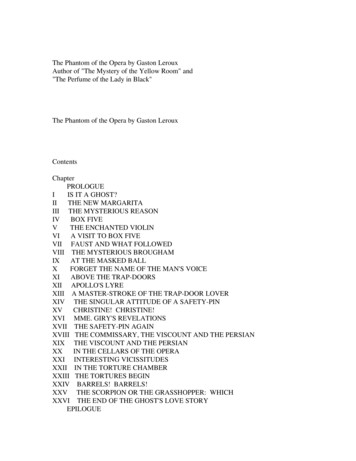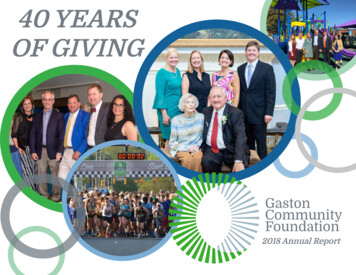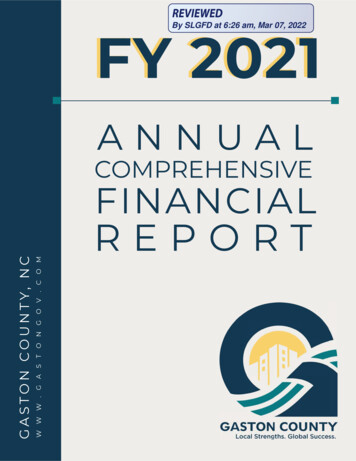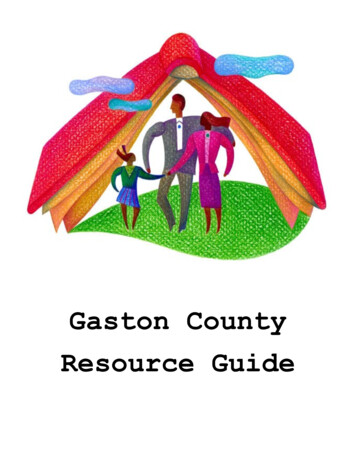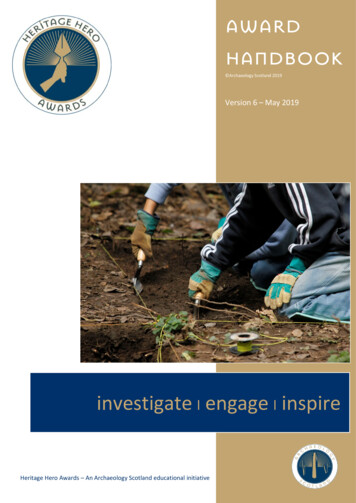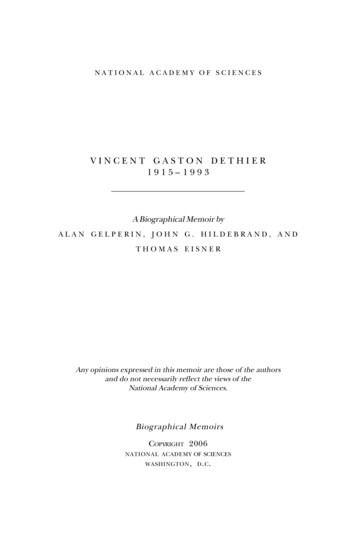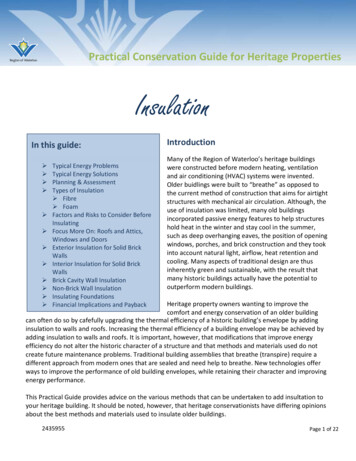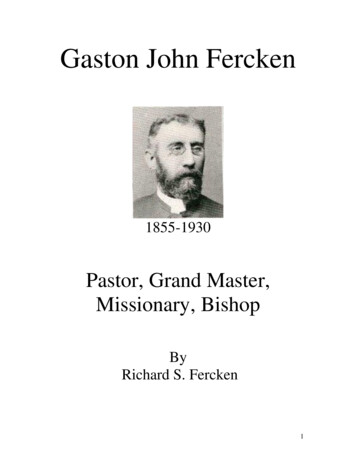
Transcription
Gaston John Fercken1855-1930Pastor, Grand Master,Missionary, BishopByRichard S. Fercken1
ForwardThe contents of this document are taken from variousChurch records and Books, personal letters, passenger lists,birth, death, marriage records, and put together inChronological order to show what Rev. Gaston Fercken’slife was like. It tells about the different Churches heministered in. The areas he traveled to and from. It alsogives some personal information on him and his family.When information was use from a source, the source isshown in the footnote at the bottom of the page. Noconclusion should be drawn while reading this documentdue to the fact that we don’t have all records involved todraw a proper conclusion.I wish to thank Bishop Serge Theriault of the ChristianCatholic Church of Canada, and Grand Master of the“Order of the Crown of Thorns”. His Biography on Rev.Gaston Fercken guided me to make contact with him, andgave me the inspiration to put this work together. Workingtogether we located the various documents on Rev. GastonFercken and his family.I also wish to thank Ben Wellink from The Netherlands,out of his love of Genealogy and the only connection to theFercken family is that his wife’s Grandparents were goodfriends with a Karl and Alda Gesina Fercken. When hiswife was young she would listen to the stories Mrs.Fercken would tell. While searching The Hague and otherDutch resources the Fercken Family genealogy has been2
uncovered and advanced far beyond my wildestexpectations.My thanks to all who have help in this work eitherindirectly or directly.3
The Early YearsGaston John Fercken was born in Aleppo, Syria on 10 June1855 where his father William Esaie Fercken was a Vice-consul ofthe Netherlands to Syria.1 His mother Sophie Hortense Fautrierwas born 18 Jan. 1827, in Marseilles, France2. The daughter of oneof the soldiers who, under Napoleon, fought at Waterloo. WhenGaston was a child his father was order by the Government tolocate to Beirut being made the Consul of the Netherlands there.From seven till fourteen years old Gaston attended the privateschool of a Lutheran minister who taught him reading, spellingarithmetic, grammar, history, geography, the bible and thecatechism. He then entered the National College, a nativeinstitution, where all studies were in Arabic. Five years gave himthorough training in the language as well as other studies. Here helearned the English language. He began to work in an insuranceand mercantile office, but soon having the opportunity to travelthrough France, Italy, Tunis, Algeria, Egypt, India and Ceylon,with a wealthy manufacturer as his private interpreter, he quite theoffice. In the meantime, his parents both having died, he located atSmyrna, where his father was born, and where two of his brother’sresided.3Here he spent five years in the Austrian College, teachingand pursuing his studies, until he was granted the degree’s BA andBS. Here he also became fluent in speaking Greek. Up to this timehe had made no profession. His mother was Catholic; his fathernever identified himself with any organization. Gaston felt the call1This biographical outline is from a Letter written 11/04/1903 to Bishop W.F. Pendleton of the NewChurch Academy, Bryn Athyn, PA. This letter and others are in procession of the Church Archives.2Mother’s name taken from Gaston J. Fercken Death Certificate, Received from Yverdon-les-BainesArchives.3This statement of two brother’s is unproven no records exist that backs this up. We believe that this wastranslated incorrectly from French and should read “ where two of his uncles resided”4
to the ministry and thought he would attend a divinity school, andlook into the word to determine where he could be most at home.The choice of schools was Faculte Libre de L’Oratoire at Geneva,Switzerland4. In the free reformed Church. After two year’s ofstudy he embraced the opportunity to come to America, and finishhis theological education in the Episcopal College at Middletown,Connecticut. This school is now known as Berkeley DivinitySchool at Yale5. He then entered the Ministry of the EpiscopalChurch.6-74School name was found in “The Swiss Background of the Purrysburg Settlers” Written by Francis HaroldFercken his son.5In 1854, Bishop John Williams of Connecticut saw the need for a new seminary to be a mediatinginfluence during a time of theological division in the Episcopal Church. Williams founded the BerkeleyDivinity School in Middletown, Connecticut, naming it after George Berkeley, as a place where studentsfrom the various streams of Anglicanism could learn, worship, live and minister alongside one another.Bishop Williams, who later became Presiding Bishop of the Episcopal Church, served as Dean of theSchool himself until 1899. As indicated by the School's motto, in illa quae ultra sunt ("into the regionsbeyond"), the seminary has for over 150 years prepared clergy, educators and other leaders to servethroughout the church as part of its mission of "restoring all people to unity with God and each other inChrist." From article History of Berkley Divinity School at Yale.6This biographical outline is also from “Thirty-Three Years of Missions in the Church of the Brethren” byGalen B. Royer (1913) pages 317, 318. A picture of Gaston and his wife is on Plate 9 Opposite 304 ofsame book.7Episcopal Church, USA, Descendant of the Church of England in the U.S. Part of the AnglicanCommunion, it was formally organized in 1789 as the successor of the Church of England in the formerBritish colonies. The church accepts both the Apostles' Creed and the Nicene Creed as well as a modifiedversion of the Thirty-nine Articles of the Church of England. The highest authority in the church is theGeneral Convention, which is headed by the presiding bishop (elected by the House of Bishops). TheReformed Episcopal Church broke away from the main body in 1873. This article is from the Wikipediaonline Encyclopedia.5
The Episcopal YearsAfter finishing his theological studies in 1884 he was ordainedA Episcopal Priest on 8 June 18848 by Bishop Abraham Littlejohnof Long Island9. He then became Rector of Emmanuel EpiscopalChurch, Great River, Long Island (still in use today) 1884 to 1892.8From Book “List of Persons Ordained Deacons in the Protestants Episcopal Church From Jan. 1, 1859 ToJan. 1, 1885”Author Elijah H. Downing-1886, Publisher Thomas Whittaker, Bible House. Index page 74shows Fercken, G.J. 3092, page 65 under 3092 Gaston J.Fercken shows June 8, 1884, Bishop OrdainingLittlejohn.9Dr. Littlejohn was born in Montgomery County, N. Y., Dec. 13, 1824; was graduated at Union College in1845, and was ordained Deacon, March 18, 1848, and Priest in November, 1850, soon after entering uponthe rector ship of Christ church, Springfield, Mass. He remained in Meriden ten months. He was afterwardsRector of churches in New Haven, and Brooklyn, N. Y. In 1856, he received the degree of D. D., from theUniversity of Pennsylvania, and soon after was elected to the Presidency of Hobart College, Geneva, N. Y.For ten years he was lecturer on Pastoral Theology at the Berkeley Divinity School, Middletown. Nov. 11,1868, he was elected Bishop of Central New York, at the Episcopal Convention at Utica. He declined theappointment, and on the 19th of November was elected Bishop of Long Island, which he accepted. /chapter11.html website6
Emmanuel Episcopal ChurchTaken 10/7/2006, By Tiffani L. FerckenOn 9 September 1885 he married Selena Roberdeau Shober, inSalisbury, Rowan County, NC, at Saint lukes Catholic Church.10Selina Roberdeau ShoberShe was the daughter of Congressman Francis Shober fromNorth Carolina11. She was also the sister of the Rev. FrancisEmanuel Shober rector of St. John’s Church, Barrytown, NY12.10Taken from Marriage certificate dated September 8, 18857
Very little information is known during this time. The onlyinformation that The Episcopal Diocese of Long Island could findwas a copy of a page from a Parochial Report dated 1890. It statesthe Rev. Gaston J. Fercken Rector of Emmanuel Church, Islip(now Great River). Also states the following “The past year haswitnessed the realization of a hope long deferred. Through theliberality of members and friends of Emmanuel Church. A 5000.00 Queen Anne cottage has been erected on the church lot,to become ultimately the Rectory. It is completely furnished, andSHOBER, Francis Edwin , (father of Francis Emanuel Shober), a Representative from North Carolina;born in Salem (now Winston-Salem), N.C., March 12, 1831; attended the common schools and theMoravian School, Bethlehem, Pa.; was graduated from the University of North Carolina at Chapel Hill in1851; studied law; was admitted to the bar in 1853 and commenced practice in Salisbury, N.C., in 1854;member of the State house of commons in 1862 and 1864; served in the State senate in 1865; elected as aDemocrat to the Forty-first and Forty-second Congresses (March 4, 1869-March 3, 1873); was not acandidate for renomination in 1872; delegate to the State constitutional convention in 1875; county judge ofRowan County in 1877 and 1878; appointed Chief Clerk of the United States Senate in the Forty-fifthCongress; upon the death of Secretary John C. Burch in the Forty-seventh Congress was appointed ActingSecretary of the Senate and served from October 24, 1881, to March 3, 1883; delegate to the DemocraticNational Conventions in 1880 and 1884; again a member of the State senate in 1887; resumed the practiceof his profession; died in Salisbury, Rowan County, N.C., May 29, 1896; interment in Oakdale Cemetery.Taken from the Biographical Directory of the United States Congress.1112SHOBER, Francis Emanuel, (son of Francis Edwin Shober), a Representative from NewYork; born in Salisbury, N.C., October 24, 1860; studied under private tutors; wasgraduated from St. Stephen’s College, Annandale, N.Y., in 1880; engaged in ministerialand educational work in Dutchess County, N.Y.; reporter on the News-Press ofPoughkeepsie; pastor of St. John’s Episcopal Church at Barrytown, N.Y., 1880-1891;editor of the Rockaway Journal at Far Rockaway, N.Y.; member of the editorial staff ofthe New York World; elected as a Democrat to the Fifty-eighth Congress (March 4,1903-March 3, 1905); unsuccessful candidate for renomination in 1904; deputy taxappraiser of the State of New York in 1907 and 1908; resumed newspaper work; editor ofthe New York American until his death in New York City October 7, 1919; interment inWorcester Cemetery, Danbury, Fairfield County, Conn.8
now occupied by the present incumbent and his family.”13Photo taken 10/07/2006By Tiffani L. FerckenWhen Emmanuel Episcopal Church, 320 Great River Rd, GreatRiver, NY was contacted, Rev. Canon Domenic K. Ciannella 14sent birth, baptism, sponsor and death information on Rev. GastonJ. Fercken’s family. During this time they had the followingchildren Phoebe, born on 9 August 1886, Baptized on 5 September1886, By Bishop Abraham Littlejohn, Sponsors and Witnesseswere Hon. Francis E. Shober, Mrs. F.E Shober Jr, and MissAlexine Fercken. Francis Harold Fercken, born 6 August 1887,Baptized on 9 October 1887, Sponsors and witnesses were RevGaston Fercken, Selena Roberdeau Fercken, and William Nicoll.The Officiant was Henry Machett. William Roberdeau Fercken,was born on 25 May 1889, Baptized on 14 July 1889, Sponsorsand witnesses were Mr. & Mrs. William Bayard Cutting. He alsosent information that Gaston’s name appeared on the followingchurch records. Baptism from 22 June 1884 to last entry of 15 Feb.1892. Confirmations from 6 July 1884 to 15 Nov. 1891. Marriage1314As stated in the Episcopal Parochial Report, (1890), Episcopal Diocese of Long Island.The Rev. Dominic K. Cianella has been appointed part time Locum Tenens ofEmmanuel Church, Great River, Effective April 1, 2004. As stated in the Episcopal Life,The Dominion, News of the Diocese of Long Island, September 20049
records from 16 Dec. 1884 to 27 Jan.1889. Burial records from 9Nov. 1884 to 1 March 1892.15During this time Rev. Gaston Fercken having done translations(in Arabic) between the Christian Catholic Church16 (CCC) and thePatriarchate of Antioch (Syriac), Patriarch Ignatius Peter IIIauthorized Rev. Gaston to re-establish the Order of The Crown ofThorns (OCT). 17 He assumed leadership as the First modern DayGrand Master of OCT on 1 June 1891.18 On 27 June 189119, hisinfant son William Roberdeau Fercken dies of pneumonia at GreatRiver, NY. He is buried in the Emmanuel Episcopal ChurchCemetery.20In the April 1892 issue of the Oregon Churchman, BishopMorris of the Portland Oregon Diocese announces the coming ofRev. Gaston J. Fercken to St Stephens Cathedral 1432 SW 13TH StPortland, Oregon (still in use today). He and his family arrive on10 April 1892 Palm Sunday. During the two years that Dr Ferckenwas at St. Stephens Cathedral.21 He carried on the services atAscension Chapel.The Journal of the Fourth Convention of the ProtestantEpiscopal Church in the Diocese of Oregon that took placebetween June 16-19, 1892 states “There have been added to our listof clergy this year, the Rev G.J. Fercken from the Diocese of LongIsland.” It shows that Rev. Fercken answered the call of the roll of15From letter dated 29 June, 2004, from Rev. Canon Domenic K. Ciannella of Emmanuel EpiscopalChurch.16The Christian Catholic Rite of Community Churches originates from a Community Organization ofReligion (COR) which started in 1858, among French-Canadians. Churches bearing the name ChristianCatholic were established in Illinois and Michigan, by Rev. Dr. Charles Chiniquy (1809-1899), and inWisconsin, Manitoba, Ontario and Quebec, Canada, by Rev. J. René Vilatte (1854-1929). From theWebsite www.ccrc.ca17Oct was founded in 1239 by St Louis IX, King of France. Under the name of Ordre du Genest. Inspiredfrom the Order de la Couronne founded by Charlemagne.18This information comes from Bishop Serge Theriault of the CCC and Grand Master of OCT.19From letter dated 29 June, 2004, from Rev. Canon Domenic K. Ciannella of Emmanuel EpiscopalChurch20From letter dated 29 June, 2004, from Rev. Canon Domenic K. Ciannella of Emmanuel EpiscopalChurch21Oregon Churchman, V, 4th series, (May 1892), page 210
the clergy on Friday, June 17, 1892.22This Journal also shows TheRev. G.J. Fercken minister in charge of St. Stephens Chapel.The Journal of the Fifth Convention of the Protestant EpiscopalChurch in the Diocese of Oregon that took place between June 8,1893 states “That Rev. Gaston J. Fercken answered the call of theroll of the clergy on Friday, June 9, 1893.” It also shows that Rev.Fercken was paid 3.75 for traveling expenses.23The Journal alsostates that “Ascension Chapel, on Portland Heights, has been so farsupplied with interior finishing and fittings as to make it quite aseemly and comfortable place of worship. The Rev. Mr. Fercken,of St. Stephen’s Chapel, and members of his congregation, areconducting an interesting and promising Sunday school there, andkeeping up a Wednesday evening weekly service, with everyprospect of a good and permanent work.24 Again it states The Rev.G.J. Fercken Minister in charge of St. Stephen’s Chapel also hascharge of Ascension Chapel on Portland Heights. (1893).25 TheJournal of the Sixth Convention of the Protestant Episcopal Churchin the Diocese of Oregon that took place in June 1894 states “Other changes that have taken place in our clergy list, is as follows: Dr. Fercken to the Missionary Jurisdiction of Spokane.”26In the summer of 1892 he discovered the works of EmmanuelSwedenboug through Pastor J.L. Higgins (Swedenboug Church)27.On August 11, 1892 his infant son Gaston Esaie Fercken Jr. dies ofmeningitis at Portland Oregon.28 He is buried at Greenwood HillsCemetery, Portland, Oregon, in section 4, grave 36.2922As stated in the Journal of the Fourth Convention of the Protestant Episcopal Church in the Diocese ofOregon Held in Grace Church, Astoria on June 16-19, 1892, page 27.23As stated in the Journal of the Fifth Convention of the Protestant Episcopal Church in the Diocese ofOregon Held in Grace Church, Astoria on June 8, 1893, page 17.24As stated in the Journal of the Fifth Convention of the Protestant Episcopal Church in the Diocese ofOregon Held in Grace Church, Astoria on June 8, 1893, page 40.25As stated in the Journal of the Fifth Convention of the Protestant Episcopal Church in the Diocese ofOregon Held in Grace Church, Astoria on June 8, 1893, page 80.26As stated in the Journal of the Sixth Convention of the Protestant Episcopal Church in the Diocese ofOregon Held in Grace Church, Astoria on June 1894, page 4.27As stated in letter to Bishop Pendleton, from Montreal .Ain, France, November 14, 1903, New ChurchAcademy, Bryn Athyn, Pa, Church Archives28As stated on his Death certificate.29From Email received from Bonnie Kiser Caretaker of Greenwood Cemetery dated October 10, 2005,2:05Pm11
On 1 June 1893 he resigned his position as Grand Master ofOCT and made the following declaration: “After two years ofservice, we feel ourselves forced (for entire personal reasons), totransfer our charge of Grand Master to his Grace J. Rene Vilatte30,Primate and Archbishop of the Christian Catholics in America,whose wisdom, influence and social position will shed a greaterluster upon the Order still young, but destined, it may be, to rivalthose of a glorious past. We have transferred our charge andfunction of Grandmaster to His Eminence and to his successors inthe Christian Catholic episcopate, with full powers to confer thegrades of the Order and to make modifications in them as he maydeem fit for the well-being, honor and perpetuity of the Order.”31The Saturday Evening copy of the Woodlawn Daily DemocratNewspaper dated 30 Dec. 1893 under Church notices of SaintLukes Episcopal Church states “The Rev. Dr. Fercken of St.Stephen’s Church of Portland, Oregon will occupy the Pulpitmorning and Evening, All welcome.” The same paper for 6 Jan.1894 for Saint Lukes Episcopal Church states “Services andSermon by The Rev. Dr. Fercken of Portland at 7PM: Bible studyFriday at 7 PM, A Hearty Invitation extended to all.On 23 March 1894 Good Friday announced his intention toresign in order to accept work in the newly created missionaryDistrict of Spokane. His leaving took the congregation by surprise,and his resignation was reluctantly accepted by the people who hadcome to love and respect him.32 When St. Stephens Cathedral at1432 S W 13th St, Portland, Oregon was contacted they respondedby sending The History of St. Stephens Cathedral alone withcopies of their records that he took part in. Burials From 13 April30Joseph René Vilatte was consecrated a bishop on May 29, 1892. He worked in Green Bay, Wisconsin todevelop an alternative American Catholic Church during the years preceding and subsequent to hisconsecration as a bishop in accordance with the edict issued by His Holiness, Ignatius Peter III with FrancisXavier Alvarez, Archbishop of Ceylon as principal consecrator and the Metropolitan Archbishops,Gregarious and Athanasius as co-consecrators in the cathedral at Colombo, Ceylon. This biographicaloutline from the website: www.ecc-usa.org/Vilatte bio and pict.html.31Published in Statutes of the Chivalrous and Religious Order of the Crown of Thorns, James Kerr & Son,Fort Howard, Wisconsin, 1893, page 6-732Oregon Churchman, V, 4th series, (May 1892), page 212
1892 to 5 April 1894(Burial of his own son is recorded). Baptismsfrom 12 June 1892 to 8 April 1893. Marriages 21 September 1892to 14 April 1894. Confirmations 5 June 1892 to 25 March 1894.In December 1894, he and his family after somecorrespondence with D.L Miller and one or two others, of theChurch of the Brethren, moved to Mount Morris, Illinois, andunited with the Church of the Brethren33.During his stay in Portland, Oregon, Rev Gaston J. Ferckenpublished Among the Ruins of the Apocalyptic Cities. This bookdescribes his journey through the apocalyptic cities.3433The Church of the Brethren was organized by Alexander Mack, a miller in Schwarzenau, Germany in1708. The Church of the Brethren began as a melding of Pietist and Anabaptist ideas. The first church wasestablished in America in 1723. These churches became commonly known as German Baptist Brethren.The denomination holds the New Testament as its only creed. Historically the church has taken a strongstance for non-resistance or pacifism. Distinctive practices include believers, baptism by trine immersion, athree-fold Love Feast. This article is from Wikipedia online Encyclopedia.34Among The Ruins of the Apocalyptic Cities, By Rev. G. J. Fercken , Printing Department, Posson’sSeed Store, 208-210 Second Street, Portland Oregon ( 1893?)13
Church of the BrethrenIn due time the Mt Morris Church called him to the ministry.The Brethren Conference of 1895 approved of him as a Missionaryto Asia Minor.35 Brother Fercken and his family arrived on July13, 1895 and choose Smyrna as the headquarters for the mission.36Although the mission had been started when Christianity wasfrowned upon by the government and when severe persecutionsagainst Christians were not uncommon, real success seemed to beattending the efforts of the Brethren Mission.37On September 29,1896 the first love feast was held38. Previous to the feast, G. J.Fercken was ordained to the bishopric, D.L. Miller and H.B.Brumbaugh laying on hands.39 40 In the Asia Minor Mission, ThirdReport, Easter 1897-1898, shows 3 churches, Smyrna (modern dayIzmir), Aidin (Modern Day Aydin) , Philadelphia (Modern DayAlasehir), with the total of the three churches having the followingmembership, 1 Bishop, 3 ministers, 1 Deacon, 16 Baptized and 39total members.41 On March 10, 1897 to Brother Galen he reports19 orphans.42 On May 1, 1897 he reports the following “This mail35This biographical outline is from “Thirty-Three Years of Missions in the Church of the Brethren” byGalen B. Royer (1913) pages 317, 318. A picture of Gaston and his wife is located on Plate 9 Opposite 304of same book.36As stated in Missions in the Church of the Brethren, By Elgin S. Moyer. Brethren Publishing House,Elgin, Illinois (1931), page161.37As stated in Missions in the Church of the Brethren, By Elgin S. Moyer. Brethren Publishing House,Elgin, Illinois (1931) , page 16238The Brethren love feast is a conscious imitation of Jesus’ last supper with his disciples. It begins withfoot washing symbolizing humility and service. They then share a meal, symbolizing fellowship. Finally,they share the bread and cup communion, symbolizing participation in Christ’s suffering and death. Theremay also be hymns and a sermon, as well as a preliminary time of self-examination.39As stated in Missions in the Church of the Brethren, By Elgin S. Moyer. Brethren Publishing House,Elgin, Illinois (1931), page 194.40In letter to Prince Albert of Wittgenstein, dated 31 January 1900 he signs it G. J. Fercken, Bishop of theBrethren Church. 2/5 Mission Work in Asia Switzerland and France, Folder # 1 Gaston J. and PhoebeFercken(Brethren Historical Library and Archives) Elgin Il41As reported in Asia Minor Mission, second Report, Easter 1896-Easter 1897, 2/5 Mission Work in AsiaSwitzerland and France, Folder # 1 Gaston J. and Phoebe Fercken(Brethren Historical Library andArchives) Elgin Il42As stated in letter from Smyrna, Asia Minor, March 10, 1897, to Brother Galen. 2/5 Mission Work inAsia Switzerland and France, Folder # 1 Gaston J. and Phoebe Fercken(Brethren Historical Library andArchives) Elgin Il14
brings to Bro. D.L. and the church at large the accession bybaptism of three precious souls, among them my cousin AlphonsoFercken of the Roman Catholic Church. This makes ourmembership here in Smyrna to amount to 15”.43 He mentions “Idamy sister called on Mrs. Miller” in a letter dated November 51898.44About the middle of 1898 reverses came. The Armenianslearning of the baptism of several of the orphans becameunfriendly to the mission. They brought serious charges againstBrother Fercken which however could not be sustained, and alsoinfluenced the Turkish Government to become antagonistic. Forthe sake of his personal safety, Brother Fercken had to leave thecountry.45 He states in a letter to Mrs. Lucy A Harrold “MyCounsel, knowing my innocence and the character of the Orientalsadvised me to leave”.46 Upon hearing of the charges the Church ofthe Brethren investigated the charges and published the followingstatement to its members “Having investigated the charges madeagainst Brother Fercken, we most unhesitatingly declare our fullbelief in his innocence. We express our esteem for and confidencein our brother who has brought to suffer so much for the cause heloves and for which he made such great sacrifices. His successmade envy and ill will but the right will triumph by the grace ofGod, and in the end come off more than conqueror through himwho loved us and died for us all”. Signed J. H. Moore, W. E.Roop, May B. Oller, Lizzie Miller, And D. L. Miller.”4743As stated in letter dated May 1, 1897 from Smyrna, Asia Minor to Bro. Galen, , 2/5 Mission Work inAsia Switzerland and France, Folder # 1 Gaston J. and Phoebe Fercken(Brethren Historical Library andArchives) Elgin Il.44As stated in letter dated November 5, 1898, from Geneva, Switzerland to Bro. Galen, , 2/5 Mission Workin Asia Switzerland and France, Folder # 1 Gaston J. and Phoebe Fercken(Brethren Historical Library andArchives) Elgin Il.45As stated in Missions in the Church of the Brethren, By Elgin S. Moyer. Brethren Publishing HouseElgin, Illinois (1931) , page16346Letter dated 30 January 1899 from Gaston Fercken, Geneva, Switzerland to Brother Galen 2/5 MissionWork in Asia, Switzerland and France, Folder # 1 Gaston J. and Phoebe Fercken (Brethren HistoricalLibrary and Archives) Elgin IL.47As stated in Missions in the Church of the Brethren, By Elgin S. Moyer. Brethren Publishing House,Elgin, Illinois (1931), page 164. Also stated in the Gospel Messenger 1899, page 601.15
During this time Gaston writes “ this has been a tryingexperience for me, the most bitter experience of my life and faith, Ihave often asked myself if, had I remained in my little missionaryfield on the Mount (Mount Morris, Illinois), I would not havesaved myself this sorrow, this disgrace, this heavy and unbearableburden. But when in more hopeful moments, I have thought ofwhat Christians have suffered in the early days of the “faith onceachieved.” I did ask myself whether I ought not to bear my crosscheerfully and manfully, and rejoice that for Christ’s and truthsake, I was found worthy of suffering this most awful specimen ofpersecution.” He goes on to say that “I have selected Genevawhere I lived from 1880-1882 and where I still have friends whereI can live cheaper, especially now that my family is soon comingto join me. My poor wife is much run down by the long nervousstain brought upon her by this affair and my absence from homeabout 2 months and a half.”48In a letter dated December 23, 1898once again he mentions family, “And by some Providentialdealing, fell in Mr. Langdon’s (my brother-in-law) hands. 49The general Mission Board met in January 1899 and decidedthat Brother Fercken should be permitted to open a Mission inSwitzerland50 Where his mother tongue, French was spoken. InJune of 1899 a Sunday-school was started (in the vestry room ofthe Old Catholic Church51) at Lancy, A little village near Geneva,Switzerland. In October Gaston was called to Oyannax, France tobaptize several applicants there. 52 In 1900 Gaston’s request tobuild a Church house in Lancy was approved, with the corner stone48Letter dated 14 September 1898 from Gaston Fercken, Geneva, Switzerland to Brother Galen 2/5Mission Work in Asia, Switzerland and France, Folder # 1 Gaston J. and Phoebe Fercken (BrethrenHistorical Library and Archives) Elgin IL.49As stated in letter dated 9 December 23, 1898 from Geneva, to brother Galen, , 2/5 Mission Work in AsiaSwitzerland and France, Folder # 1 Gaston J. and Phoebe Fercken(Brethren Historical Library andArchives) Elgin Il50As stated in Missions in the Church of the Brethren, By Elgin S. Moyer. Brethren Publishing House,Elgin, Illinois (1931) , page 164.51Letter dated 30 June 1899 from Gaston Fercken, Geneva, Switzerland to Brother Galen 2/5 Mission Workin Asia, Switzerland and France, Folder # 1 Gaston J. and Phoebe Fercken (Brethren Historical Library andArchives) Elgin IL52As stated in Missions in the Church of the Brethren, By Elgin S. Moyer. Brethren Publishing House,Elgin, Illinois (1931), page 164.16
being laid 8 September 1900. Due to the poor location of thechurch house the services were moved into a rented hall in Genevain 1901 The Board order the church house sold.The board wished Elder Fercken to come into closer touch withthe home church and in 1901 asked him to come to America for afurlough. Although he did not go, his wife Selena and two childrenPhoebe and Francis Harold did sail from Le Havre by the steamerChampagne on 27 April 1901.53 Upon there arrival they stayedwith family at 280 Saint Nicholas Ave54, and 234 West 122 St55,NYC, NY. In a letter he states about his furlough “I can accept itnot, the work here being still in its infancy.”56 On 25 November1901 Gaston writes “My dear ones arrived safely here on Fridaynoon last, after a rather pleasant trip on the Ocean”.57 In April 1902Gaston writes “I shall sail from Boulogne-Sur-Mer for New Yorkon the 17 April on board the Dutch Steamer Ryndam of theHolland America Line. My son Harold is coming with me and Ishall try to place him this fall at Mount Morris College”.58 Then inthe spring of 1903 he returned to the US again to attend the AnnualConference.Passenger arrival records of La Champagne sailing from LeHavre, Seine-Inferior, France, on April 11, 1903, and arriving atthe Port of New York 19 April 1903 show him going to Mount53Letter dated 29 April 1901 from Gast
The Early Years Gaston John Fercken was born in Aleppo, Syria on 10 June 1855 where his father William Esaie Fercken was a Vice-consul of the Netherlands to Syria.1 His mother Sophie Hortense Fautrier . graduated from St. Stephen's College, Annandale, N.Y., in 1880; engaged in ministerial

